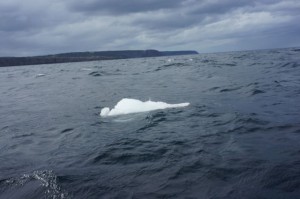“That’s the biggest iceberg I’ve ever seen in these waters,” said Harry Spurrell, our host, as he took us on a tour of the icebergs around Torbay in Newfoundland today. We were out in his speedboat to get up close and personal with the bergs that could impede our progress across the North Atlantic.

From Torbay we could see three major bergs, impressive and majestic, especially when you consider that they are made of ice that could be tens of thousands of years old. But it’s not actually these big, conspicuous, impossible-to-miss kind of icebergs that we’re worried about. It’s their evil offspring, the fragments of ice no bigger than a refrigerator that would be so difficult to spot from a rowboat, especially at night or when they are disguised by the whitecaps of waves. As soon as the seas get more than a few feet high, we wouldn’t even see such a fragment until we were right on top of it and it was punching its way through our hull.

We saw many of these fragments today, drifting downwind of the bigger bergs that spawned them. They came in all kinds of shapes, many of them sharply irregular, sticking up from the ocean in strange shapes like witches’ hats or swans or sharks’ fins.
In a few weeks’ time these fragments will be gone. Maybe even their parents bergs will have melted away. We could see the meltwater pouring off them today in waterfalls cascading down their sides. They are diminishing rapidly.

But we have an immovable deadline to get to London before the start of the Olympics – or at the latest before I have to go to Yale for the start of the semester in mid-August. The clock is ticking.

Hi Roz – How big are these bergs below the surface? And is there any way you can see them using technological means so that you get a warning before they’re close enough to cause problems?
Wow nice shot…they sure are nice to look at. :/
Wow, that’s a lot of margaritas. Hope you can get out soon.
You are very wise to be worried about ice slivers. Ice on a river cut a boat like a knife that my college rowing club borrowed – fortunately not my crew’s boat. Just love your imagination and language – witches’ hats, swans or shark fins. Enjoy your time on land. I am sure when you get to Yale you’ll have stories to tell at Mystic Seaport in Connecticut where there’s rich maritime history.
Only ~9% is visible above the surface. Perhaps a sounder or fish finder could be used as a warning device although a continuously operating sounder would be a prohibitive load on the electrical system.
An interesting idea. Unfortunately the ice field coincides with the area most prone to fog. When we were out there yesterday we could see this huge fog bank lurking on the horizon. We probably won’t have enough power to run anything more than the bare essentials.
To leave sooner than later, would this be a measured risk, or a foolish risk?
Dear Roz, you have worked for Earth health. Nature is now advising you gently: Ne pas sortir. A otra cosa mariposa.
Howdy Roz, Wow! I did not realize how dangerous those bergy bits could be. Especially in the fog at night with whitecaps! A 3″ steel hull with frames at 12″ on center might be in order. Do they show up on radar? We camped on the snow last week with a beautiful view of Mt. Rainier. The glaciers are still there and so are the moon and stars. All the best to you and Andrew, Stephen
Cargo ships, pirates, inky squid, rogue water makers, failed electrical systems (“red eye of doom”), stuck para-anchors, uncooperative winds and currents, frisky dorado… and now icebergs to be added your list of challenges. I’m beginning to think rowing an ocean isn’t easy!
Hang in there guys. Soon you’ll be on your way!